[English] 日本語
 Yorodumi
Yorodumi- PDB-6cx1: Cryo-EM structure of Seneca Valley Virus-Anthrax Toxin Receptor 1... -
+ Open data
Open data
- Basic information
Basic information
| Entry | Database: PDB / ID: 6cx1 | ||||||
|---|---|---|---|---|---|---|---|
| Title | Cryo-EM structure of Seneca Valley Virus-Anthrax Toxin Receptor 1 complex | ||||||
 Components Components |
| ||||||
 Keywords Keywords | VIRUS / Virus-receptor complex / Picornavirus / Senecavirus / Anthrax Toxin Receptor | ||||||
| Function / homology |  Function and homology information Function and homology informationsymbiont-mediated suppression of host cytoplasmic pattern recognition receptor signaling pathway via inhibition of IRF7 activity / host cell nucleolus / adhesion receptor-mediated virion attachment to host cell / filopodium membrane / negative regulation of extracellular matrix assembly / symbiont-mediated suppression of host TRAF-mediated signal transduction / blood vessel development / symbiont-mediated suppression of host cytoplasmic pattern recognition receptor signaling pathway via inhibition of RIG-I activity / Uptake and function of anthrax toxins / lamellipodium membrane ...symbiont-mediated suppression of host cytoplasmic pattern recognition receptor signaling pathway via inhibition of IRF7 activity / host cell nucleolus / adhesion receptor-mediated virion attachment to host cell / filopodium membrane / negative regulation of extracellular matrix assembly / symbiont-mediated suppression of host TRAF-mediated signal transduction / blood vessel development / symbiont-mediated suppression of host cytoplasmic pattern recognition receptor signaling pathway via inhibition of RIG-I activity / Uptake and function of anthrax toxins / lamellipodium membrane / collagen binding / symbiont-mediated suppression of host cytoplasmic pattern recognition receptor signaling pathway via inhibition of MAVS activity / substrate adhesion-dependent cell spreading / picornain 3C / T=pseudo3 icosahedral viral capsid / host cell cytoplasmic vesicle membrane / actin filament binding / transmembrane signaling receptor activity / channel activity / symbiont-mediated suppression of host cytoplasmic pattern recognition receptor signaling pathway via inhibition of TBK1 activity / actin cytoskeleton organization / monoatomic ion transmembrane transport / symbiont-mediated suppression of host toll-like receptor signaling pathway / symbiont-mediated suppression of host cytoplasmic pattern recognition receptor signaling pathway via inhibition of IRF3 activity / ubiquitinyl hydrolase 1 / entry receptor-mediated virion attachment to host cell / cysteine-type deubiquitinase activity / RNA helicase activity / endosome membrane / RNA helicase / external side of plasma membrane / RNA-directed RNA polymerase / cysteine-type endopeptidase activity / viral RNA genome replication / RNA-directed RNA polymerase activity / DNA-templated transcription / symbiont entry into host cell / virion attachment to host cell / host cell nucleus / structural molecule activity / cell surface / ATP hydrolysis activity / proteolysis / RNA binding / ATP binding / metal ion binding / membrane / plasma membrane Similarity search - Function | ||||||
| Biological species |  Homo sapiens (human) Homo sapiens (human) Senecavirus A Senecavirus A | ||||||
| Method | ELECTRON MICROSCOPY / single particle reconstruction / cryo EM / Resolution: 3.8 Å | ||||||
 Authors Authors | Jayawardena, N. / Burga, L. / Easingwood, R. / Takizawa, Y. / Wolf, M. / Bostina, M. | ||||||
 Citation Citation |  Journal: Proc Natl Acad Sci U S A / Year: 2018 Journal: Proc Natl Acad Sci U S A / Year: 2018Title: Structural basis for anthrax toxin receptor 1 recognition by Seneca Valley Virus. Authors: Nadishka Jayawardena / Laura N Burga / Richard A Easingwood / Yoshimasa Takizawa / Matthias Wolf / Mihnea Bostina /   Abstract: Recently, the use of oncolytic viruses in cancer therapy has become a realistic therapeutic option. Seneca Valley Virus (SVV) is a newly discovered picornavirus, which has earned a significant ...Recently, the use of oncolytic viruses in cancer therapy has become a realistic therapeutic option. Seneca Valley Virus (SVV) is a newly discovered picornavirus, which has earned a significant reputation as a potent oncolytic agent. Anthrax toxin receptor 1 (ANTXR1), one of the cellular receptors for the protective antigen secreted by , has been identified as the high-affinity cellular receptor for SVV. Here, we report the structure of the SVV-ANTXR1 complex determined by single-particle cryo-electron microscopy analysis at near-atomic resolution. This is an example of a shared receptor structure between a mammalian virus and a bacterial toxin. Our structure shows that ANTXR1 decorates the outer surface of the SVV capsid and interacts with the surface-exposed BC loop and loop II of VP1, "the puff" of VP2 and "the knob" of VP3. Comparison of the receptor-bound capsid structure with the native capsid structure reveals that receptor binding induces minor conformational changes in SVV capsid structure, suggesting the role of ANTXR1 as an attachment receptor. Furthermore, our results demonstrate that the capsid footprint on the receptor is not conserved in anthrax toxin receptor 2 (ANTXR2), thereby providing a molecular mechanism for explaining the exquisite selectivity of SVV for ANTXR1. | ||||||
| History |
|
- Structure visualization
Structure visualization
| Movie |
 Movie viewer Movie viewer |
|---|---|
| Structure viewer | Molecule:  Molmil Molmil Jmol/JSmol Jmol/JSmol |
- Downloads & links
Downloads & links
- Download
Download
| PDBx/mmCIF format |  6cx1.cif.gz 6cx1.cif.gz | 188 KB | Display |  PDBx/mmCIF format PDBx/mmCIF format |
|---|---|---|---|---|
| PDB format |  pdb6cx1.ent.gz pdb6cx1.ent.gz | 146.3 KB | Display |  PDB format PDB format |
| PDBx/mmJSON format |  6cx1.json.gz 6cx1.json.gz | Tree view |  PDBx/mmJSON format PDBx/mmJSON format | |
| Others |  Other downloads Other downloads |
-Validation report
| Summary document |  6cx1_validation.pdf.gz 6cx1_validation.pdf.gz | 1 MB | Display |  wwPDB validaton report wwPDB validaton report |
|---|---|---|---|---|
| Full document |  6cx1_full_validation.pdf.gz 6cx1_full_validation.pdf.gz | 1 MB | Display | |
| Data in XML |  6cx1_validation.xml.gz 6cx1_validation.xml.gz | 33.9 KB | Display | |
| Data in CIF |  6cx1_validation.cif.gz 6cx1_validation.cif.gz | 50.1 KB | Display | |
| Arichive directory |  https://data.pdbj.org/pub/pdb/validation_reports/cx/6cx1 https://data.pdbj.org/pub/pdb/validation_reports/cx/6cx1 ftp://data.pdbj.org/pub/pdb/validation_reports/cx/6cx1 ftp://data.pdbj.org/pub/pdb/validation_reports/cx/6cx1 | HTTPS FTP |
-Related structure data
| Related structure data |  7772MC M: map data used to model this data C: citing same article ( |
|---|---|
| Similar structure data |
- Links
Links
- Assembly
Assembly
| Deposited unit | 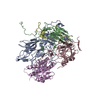
|
|---|---|
| 1 | x 60
|
| 2 |
|
| 3 | x 5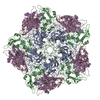
|
| 4 | x 6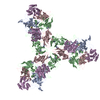
|
| 5 | 
|
| Symmetry | Point symmetry: (Schoenflies symbol: I (icosahedral)) |
- Components
Components
| #1: Protein | Mass: 21026.668 Da / Num. of mol.: 1 Source method: isolated from a genetically manipulated source Source: (gene. exp.)  Homo sapiens (human) / Gene: ANTXR1, ATR, TEM8 / Production host: Homo sapiens (human) / Gene: ANTXR1, ATR, TEM8 / Production host:  Homo sapiens (human) / References: UniProt: Q9H6X2 Homo sapiens (human) / References: UniProt: Q9H6X2 |
|---|---|
| #2: Protein | Mass: 28459.969 Da / Num. of mol.: 1 / Fragment: residues 674-931 / Source method: isolated from a natural source / Source: (natural)  Senecavirus A / References: UniProt: A0A1U9IRU2, UniProt: Q155Z9*PLUS Senecavirus A / References: UniProt: A0A1U9IRU2, UniProt: Q155Z9*PLUS |
| #3: Protein | Mass: 29870.316 Da / Num. of mol.: 1 / Fragment: residues 162-429 / Source method: isolated from a natural source / Source: (natural)  Senecavirus A / References: UniProt: A0A1U9IRU2, UniProt: Q155Z9*PLUS Senecavirus A / References: UniProt: A0A1U9IRU2, UniProt: Q155Z9*PLUS |
| #4: Protein | Mass: 26353.938 Da / Num. of mol.: 1 / Fragment: residues 435-672 / Source method: isolated from a natural source / Source: (natural)  Senecavirus A / References: UniProt: A0A1U9IRU2, UniProt: Q155Z9*PLUS Senecavirus A / References: UniProt: A0A1U9IRU2, UniProt: Q155Z9*PLUS |
| #5: Protein | Mass: 5998.467 Da / Num. of mol.: 1 / Fragment: residues 93-150 / Source method: isolated from a natural source / Source: (natural)  Senecavirus A / References: UniProt: A0A218L148, UniProt: Q155Z9*PLUS Senecavirus A / References: UniProt: A0A218L148, UniProt: Q155Z9*PLUS |
-Experimental details
-Experiment
| Experiment | Method: ELECTRON MICROSCOPY |
|---|---|
| EM experiment | Aggregation state: PARTICLE / 3D reconstruction method: single particle reconstruction |
- Sample preparation
Sample preparation
| Component | Name: Seneca Valley Virus-Anthrax Toxin Receptor 1 complex / Type: VIRUS / Entity ID: all / Source: MULTIPLE SOURCES |
|---|---|
| Molecular weight | Value: 6.5 MDa / Experimental value: NO |
| Source (natural) | Organism:  Senecavirus A Senecavirus A |
| Details of virus | Empty: NO / Enveloped: NO / Isolate: STRAIN / Type: VIRION |
| Virus shell | Name: Capsid / Diameter: 300 nm / Triangulation number (T number): 3 |
| Buffer solution | pH: 7.4 |
| Buffer component | Name: Phosphate Buffer |
| Specimen | Conc.: 0.2 mg/ml / Embedding applied: NO / Shadowing applied: NO / Staining applied: NO / Vitrification applied: YES / Details: A homogenous sample containing full capsids |
| Specimen support | Grid mesh size: 300 divisions/in. / Grid type: Quantifoil R1.2/1.3 |
| Vitrification | Instrument: FEI VITROBOT MARK IV / Cryogen name: ETHANE / Humidity: 100 % / Chamber temperature: 293 K / Details: Blot force 0, 3 sec blotting time |
- Electron microscopy imaging
Electron microscopy imaging
| Experimental equipment |  Model: Talos Arctica / Image courtesy: FEI Company |
|---|---|
| Microscopy | Model: FEI TALOS ARCTICA |
| Electron gun | Electron source:  FIELD EMISSION GUN / Accelerating voltage: 200 kV / Illumination mode: FLOOD BEAM FIELD EMISSION GUN / Accelerating voltage: 200 kV / Illumination mode: FLOOD BEAM |
| Electron lens | Mode: BRIGHT FIELD / Nominal magnification: 73000 X / Nominal defocus max: 3500 nm / Nominal defocus min: 500 nm / Cs: 2.7 mm |
| Specimen holder | Cryogen: NITROGEN |
| Image recording | Electron dose: 39 e/Å2 / Film or detector model: FEI FALCON III (4k x 4k) |
- Processing
Processing
| Software | Name: PHENIX / Version: 1.12_2829: / Classification: refinement | ||||||||||||||||||||||||||||||||||||||||
|---|---|---|---|---|---|---|---|---|---|---|---|---|---|---|---|---|---|---|---|---|---|---|---|---|---|---|---|---|---|---|---|---|---|---|---|---|---|---|---|---|---|
| EM software |
| ||||||||||||||||||||||||||||||||||||||||
| CTF correction | Type: PHASE FLIPPING AND AMPLITUDE CORRECTION | ||||||||||||||||||||||||||||||||||||||||
| Particle selection | Num. of particles selected: 7457 | ||||||||||||||||||||||||||||||||||||||||
| Symmetry | Point symmetry: I (icosahedral) | ||||||||||||||||||||||||||||||||||||||||
| 3D reconstruction | Resolution: 3.8 Å / Resolution method: FSC 0.143 CUT-OFF / Num. of particles: 6782 / Num. of class averages: 1 / Symmetry type: POINT | ||||||||||||||||||||||||||||||||||||||||
| Atomic model building | B value: 100 / Protocol: RIGID BODY FIT / Space: REAL / Target criteria: CC | ||||||||||||||||||||||||||||||||||||||||
| Refine LS restraints |
|
 Movie
Movie Controller
Controller


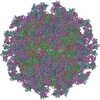

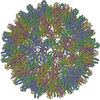

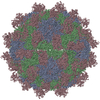
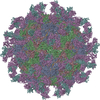
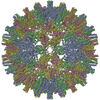
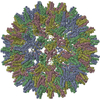
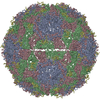

 PDBj
PDBj








